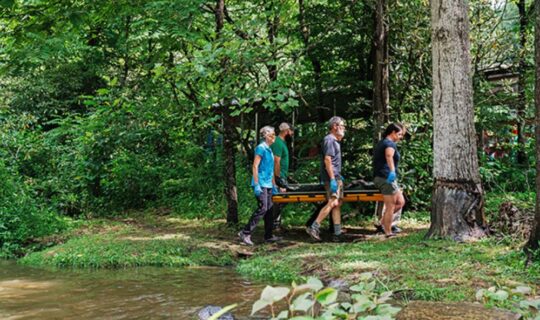

Embarking on outdoor adventures as a family is a wonderful way to bond, create lasting memories, and instill a love for nature in children.
To make the most of these experiences, it’s crucial to incorporate wilderness survival tips that ensure the safety and engagement of every family member. In this guide, we’ll explore advice for families on teaching survival skills to children and ensuring their well-being during outdoor escapades.
1. Basic Wilderness Safety:

A. Stay Together:
- Buddy System: Establish a buddy system to ensure that no one gets separated from the group.
- Set Boundaries: Define clear boundaries for exploration and make sure everyone is aware of the designated area.
B. Communication:
- Whistles and Signals: Teach children to use whistles for communication. Establish simple signals to convey messages.
- Plan and Review: Discuss the day’s plan with everyone and review safety procedures before starting any outdoor activity.
2. Teaching Survival Skills:
A. Navigation:
- Map Reading: Familiarize children with basic map reading skills. Involve them in planning routes for short hikes.
- Use of Compass: Teach the use of a compass for basic navigation. Engage in fun activities that involve compass use.
- If you want to learn more about Navigation, try our SOLO Southeast One-Day Navigation Course.
B. Shelter Building:
- Tarp Tents: Practice setting up simple tarp tents or shelters during family camping trips.
- Nature’s Materials: Encourage creativity by using natural materials like branches and leaves for constructing small shelters.
C. Fire Safety:
- Fire Building Basics: Teach the principles of fire building, emphasizing safety measures such as maintaining a safe distance and keeping a water source nearby.
- Campfire Cooking: Involve children in campfire cooking activities, teaching them the importance of fire for warmth and food preparation.
D. Wildlife Awareness:
- Animal Tracks: Learn about local wildlife by identifying animal tracks. Discuss safety measures regarding encounters with wildlife.
- Respect for Nature: Instill a respect for wildlife and the environment, emphasizing the importance of observing from a distance.
3. Safety Gear and Preparedness:

A. First Aid Kit:
- Child-Friendly Supplies: Customize a first aid kit with child-friendly supplies. Include bandages, antiseptic wipes, and any necessary medications.
- First Aid Training: Provide basic first aid training for older children. Teach them how to respond to minor injuries.
- Our most popular first aid kit is the Med Kit 7.0. We like it because it keeps the water out of our critical supplies while on the river.
B. Weather Preparedness:
- Dress Appropriately: Ensure everyone is dressed for the weather. Pack extra layers and rain gear as needed.
- Weather Monitoring: Keep an eye on weather forecasts and be prepared to adapt plans based on changing conditions.
4. Engagement and Fun:

A. Nature Exploration:
- Nature Scavenger Hunts: Create scavenger hunts to engage children in exploring and observing the natural environment.
- Nature Journals: Encourage children to keep nature journals, documenting their observations and experiences.
B. Outdoor Games:
- Survival Games: Introduce survival-themed games that involve problem-solving and teamwork.
- Navigation Challenges: Create simple navigation challenges to make learning navigation skills enjoyable.
C. Storytelling:
- Campfire Stories: Share or create family-friendly campfire stories to foster a sense of imagination and connection to nature.
- Wilderness Legends: Explore local wilderness legends or folklore, adding a touch of mystery to outdoor adventures.
5. Responsible Outdoor Ethics:

A. Leave No Trace:
- Pack It In, Pack It Out: Instill the principle of leaving no trace by packing out all waste.
- Respect Wildlife: Teach children the importance of respecting wildlife by observing and not disturbing their natural behaviors.
B. Trail Etiquette:
- Stay on Designated Trails: Emphasize the importance of staying on marked trails to preserve the natural habitat.
- Trail Courtesy: Teach trail etiquette, including yielding to other hikers and minimizing noise.
Incorporating these wilderness survival tips into family adventures not only ensures everyone’s safety but also transforms outdoor experiences into valuable learning opportunities.
Teaching survival skills in a fun and engaging manner, families can enjoy the wonders of nature together, fostering a sense of confidence, connection, and appreciation for the great outdoors.



